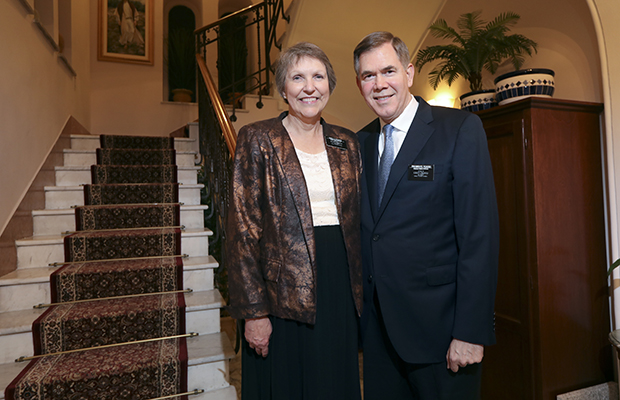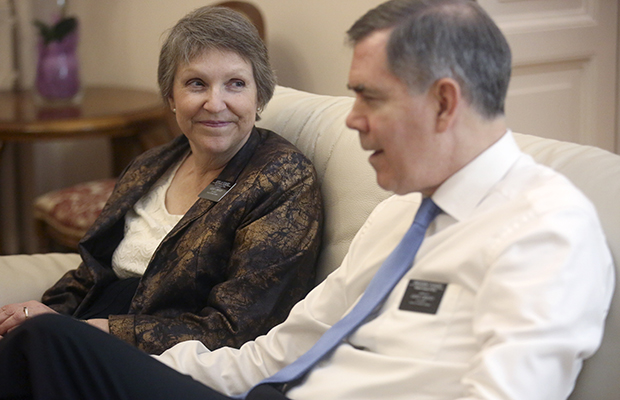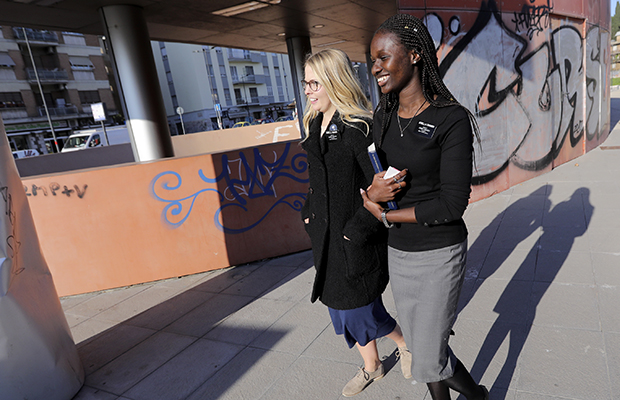As Rome Italy Temple Dedication Nears, Missionary Work Accelerates in Italy
Contributed By Scott Taylor, Church News managing editor

The Rome Italy Temple in Rome, Italy, on Friday, November 16, 2018.
Article Highlights
- The Rome Italy Temple will be dedicated March 10–12, 2019.
- The temple’s construction has helped missionaries tell more people about the Church.
“We want to fill the Rome Italy Temple with sons and daughters of God from Italy and do the work for their Italian ancestors. The vision we’re striving to create is filling the Rome Italy Temple—to meet that, we’ve got a long way to go.” —Michael D. Pickerd, Italy Rome Mission president
Related Links
ROME, ITALY
When President Michael D. Pickerd of the Italy Rome Mission and his wife, Sister Marian W. Pickerd, welcome missionaries to the mission home—whether it be new arrivals, those currently serving, or the elders and sisters departing for home—they have a pretty good sense of what the missionaries are feeling.
The 1920s villa on Via Cimone, situated northeast of the Eternal City’s historical and tourist-laden central district, has functioned as the mission home since the early 1970s. In fact, both President and Sister Pickerd served as Rome-assigned young missionaries in the ’70s, and the mission home they have resided in as mission president and companion for the past 30 months is the same from their service as young missionaries four decades ago.
“The missionaries walk through the same doors we walked through, they get interviewed by the mission president in the same office we were interviewed in, and we have their final testimonies in the same room that we did,” said President Pickerd.
Also recalling her weekly district meetings in the same villa while serving in that area of Rome for seven months, Sister Pickerd says her husband reminds their missionaries they are among the thousands to spend time in the multilevel mission home that can easily sleep 30-plus arriving or departing missionaries.
“It was beautiful to come ‘home’ and remember the memories of our mission president, the people we had known before, the converts,” she said, adding, “It’s a beautiful house—we’re lucky to be here.”
The Pickerds join the missionaries and Latter-day Saints in Rome and throughout Italy in looking forward to the coming of another special “house”—the Rome Italy Temple, or “house of the Lord,” which debuts in a public open house next month prior to its March 2019 dedication.
A step and a beacon
The temple and its adjacent buildings—all sitting on a 15-acre elevated site about 10 kilometers (6 miles) northeast from the Roma Termini central station—are a result of the prayers, faith, efforts, and service of tens of thousands of Latter-day Saints and missionaries throughout Italy over the years.
It is, as President Pickerd says, another progressive step of Zion being established in Italy, providing in-country temple worship and ordinances to Church members of the peninsula nation jutting into the Mediterranean Sea.

A diorama of the Rome Italy Temple complex, including (clockwise from right) the temple, patron housing and administrative offices, visitors’ center, and stake center. Photo by Scott Taylor.

The 1852 edition of the Italian translation of the Book of Mormon. The book is scheduled to be placed in the new Rome Italy Temple Visitors’ Center next month.
But with the construction and dedication of a temple, he adds, comes the realization there is much more to do.
“This is a great achievement, but it’s not the end,” President Pickerd said. “We want to fill the Rome Italy Temple with sons and daughters of God from Italy and do the work for their Italian ancestors. The vision we’re striving to create is filling the Rome Italy Temple—to meet that, we’ve got a long way to go.”
In other words, member and missionary work has helped to bring a temple to Italy, and that temple in turn will bless the lives of members and help foster additional opportunities for missionaries.
“The temple is a beacon, a great missionary tool for us as we point people toward it,” said Elder Bryce Dickey, a missionary from Happy Valley, Oregon, serving in Rome. “It helps them see that this Church isn’t just something small and isn’t just an American church. Instead, it’s a global Church that is fulfilling prophecy. It’s going to fill the whole earth.”
Elder Dickey points to the temple and the visitors’ center tying a latter-day church to the biblical lands traveled by ancient Apostles of the New Testament as “a great indicator that the Lord’s work is rolling forth.”
The Church in Italy
Modern-day missionary work in Italy began in 1850, when Elder Lorenzo Snow of the Quorum of the Twelve Apostles arrived in Genova with companions Thomas B. H. Stenhouse and Joseph Toronto. They headed to northern Italy’s Piedmont Valley and worked primarily with the Waldenses, a protestant religious group of French origin.
Over the next four years, the Book of Mormon was translated into Italian and some 220 converts were baptized. However, the immigration of most members to join the Saints in and around Salt Lake City, coupled with local opposition to the Church, resulted in active proselytizing ending in the 1860s.
World War II military personnel assigned to Italy helped restart local worship services and ordinances at bases there in the 1940s, while Italians converted elsewhere in Europe also returned home the next two decades. In 1966, the first branch was organized and the Italian Mission reopened—more than a century after the arrival of Elder Snow.
Membership in Italy has grown from 66 in 1967 to surpassing 7,000 in 1978, to 12,000 in 1985, to 21,000 in 2005, and to nearly 27,000 in 101 congregations today. The country’s two missions are headquartered in Rome and Milan; additional previous missions were located in Padova and Catania.

Sister Sadie Decker, center, and Sister Carolyne Dwomoh talk with Rowena Dayandayan, left, as part of their finding efforts in Rome, Italy, on Saturday, November 17, 2018. Photo by Kristin Murphy, Deseret News.
Key agreements
A pair of governmental legislations in the past quarter-century have aided the Church in Italy. In 1993, the Church received formal legal status—more as a corporate entity than a religious denomination—with a key benefit being the ability to buy and sell properties, build chapels, and provide services.
On July 30, 2012, Italy President Giergio Napolitano signed the Intesa con lo Stato—known simply among local leaders and members as the “intesa”—which gave The Church of Jesus Christ of Latter-day Saints official status as a church and “partner of the state.”
The intesa grants greater freedoms and opportunities to the Church as both a religion and a charitable organization, said Elder Massimo De Feo, a native of Italy and General Authority Seventy who currently serves in the Europe Area Presidency. He too served as a full-time missionary in the Italy Rome Mission, from 1981 to 1983.
Benefits include bishops and stake presidents being able to perform marriages (without having to seek a single-use authorization that previously took up to a year or two to receive), local leaders being able to minister in public hospitals and prisons, visa processes being streamlined for missionaries, and member tithes and offerings being considered as approved tax deductions, said Elder De Feo in a 2017 interview.
One unique element of the intesa agreement allows officially recognized churches to receive state donations of tax-generated funds.
“All the religions recognized in Italy do that, except us. We refused to receive the government funds to operate our religion—that’s part of the agreement,” said Elder De Feo, noting the Church’s practice of self-reliance. “It was a decision made by the Church. We’re the only one in Italy who doesn’t receive this money.”

Sister Marian W. Pickerd and President Michael D. Pickerd pose for a portrait at the mission home in Rome, Italy, on Friday, November 16, 2018. Photo by Kristin Murphy, Deseret News.
Diverse demographics
The population’s demographics are changing in Rome and throughout Italy, with people coming from across the globe the past couple of decades in search of opportunity or political refuge. Italy serves as the Mediterranean’s front step for refugees migrating from Africa or the Middle East.
“When we were here 40 years ago, everyone was Italian,” Sister Pickerd said. “Now they’re from all over the world—South Americans, Africans, Filipinos—and that’s reflecting in the Church here too.”
That includes not just the membership but the missionary force as well. Take, for example, Sister Carolyne Dwomoh of Campegine, Italy, who is capable to testify in four languages—her native Twi, Italian, English, and Spanish.
Her parents both served as missionaries in their native Ghana and later met, married, and started a family. When Sister Dwomoh was 11, her family relocated from Ghana to Italy, with her father currently serving as bishop of the Reggio Emilia Ward in northern Italy, near Parma.
“It’s a very diverse missionary effort,” she said. “Being in Rome, we meet people from all over the world each and every day. The beautiful thing is that I can always testify about the fact that the gospel is for everyone—no matter where you’re from, no matter what your culture is, it’s for everyone.”
Missionaries currently assigned to the Rome mission include a number with heritage ties to Italy, having ancestors who immigrated previously to North or South America. The missionaries may represent their respective family’s first, second, or third generation born outside of Italy; some even have Italian citizenship through their parents.
“Wherever they come from, they develop a love for the people, a love for the culture, and certainly a love for the food,” said President Pickerd. “But it starts with the people, because Italian people are very warm, very family-focused, and they value life in terms of its sanctity.”

Sister Marian W. Pickerd listens as President Michael D. Pickerd of the Italy Rome Mission talks at the mission home in Rome, Italy, on Friday, November 16, 2018. Photo by Kristin Murphy, Deseret News.
Interest among families
The Rome Italy Temple already is drawing their interest, with missionaries underscoring the impact the sacred building and ordinances can have on families.
“The Italians are very curious people, so they want to know what this building is,” said Sister Sadie Decker of McKinney, Texas, of the temple and its high-profile location less than 250 meters (820 feet) from the upscale Porta di Roma mall just off the Grande Raccordo Anulare, the motorway encircling central Rome.
The visibility of a new religious edifice and the scheduled open house has become a popular conversation piece for missionaries when they contact people on the street or on public transportation.
“It’s a really easy way for us to talk to people because they’re curious and they want to at least come and see it,” she said. “And they’re very family oriented, so when we tell them about eternal families and how inside a temple we can become an eternal family, that really piques their interest.”

Elder Travis Wagstaff looks around a metro car as part of his finding efforts in Rome, Italy, on Saturday, November 17, 2018. Photo by Kristin Murphy, Deseret News.
Missionary work, then and now
Just as the membership numbers have steadily risen over the years, so has the missionary work evolved. When the Pickerds served in the 1970s, there were considerably fewer members to work with, much of the proselyting was door-to-door contacting, and worship services were conducted in rented facilities, typically hotels.
Now, the Church owns dedicated meetinghouses—an increasing number of Church-constructed buildings to add to the converted homes and commercial buildings that have served as previous meeting locations.
With more Latter-day Saints to work with, missionaries look for ways to involve the members in finding, inviting, teaching, and reactivating. In addition to applying the Spirit-directed efforts taught by Preach My Gospel, finding and inviting efforts have gone to the streets, with missionaries contacting and seeking service opportunities when on the move from one location to the next—on sidewalks, in the parks, and on the buses, metros, and trains.
“As I think of what the missionaries did in the past, our role in the ongoing work is to find people who are ready,” said Elder Travis Wagstaff of Holladay, Utah. “Seeds have been planted, and they continue to be planted every day, and we’re here to find the elect, the people who are ready to hear this gospel.
“The Church has been here for a while,” he added, “and I think it’s ready to be harvested.”

The Italy Rome Mission home, a 1920s villa on Via Cimone in northeastern Rome. Photo by Scott Taylor.

Sister Sadie Decker and Sister Carolyne Dwomoh walk through Rome, Italy, on Saturday, November 17, 2018. Photo by Kristin Murphy, Deseret News.

Elder Travis Wagstaff and Elder Bryce Dickey laugh after finishing lunch in Rome, Italy, on Saturday, November 17, 2018. Photo by Kristin Murphy, Deseret News.
